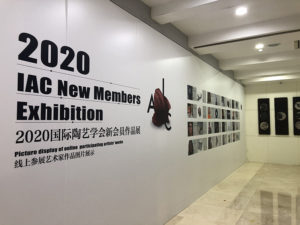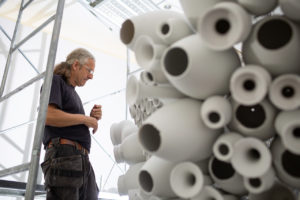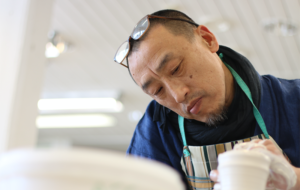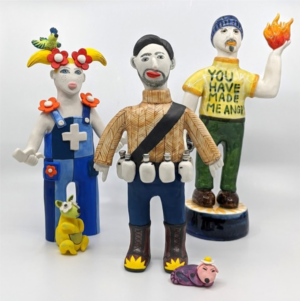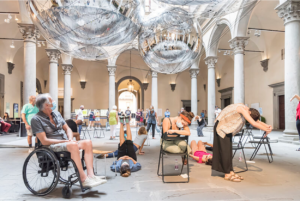Wayne Higby – Seminar
|
I am Wayne Higby, Director and Chief Curator of the Alfred Ceramic Art Museum at Alfred University, Alfred, New York, USA. I have been asked to speak about – New Trends of International Ceramic Art Development. Considering our time frame, I must turn away from elaborate, in-depth considerations of the topic and offer some quick general impressions regarding the State of American Ceramic Art. |
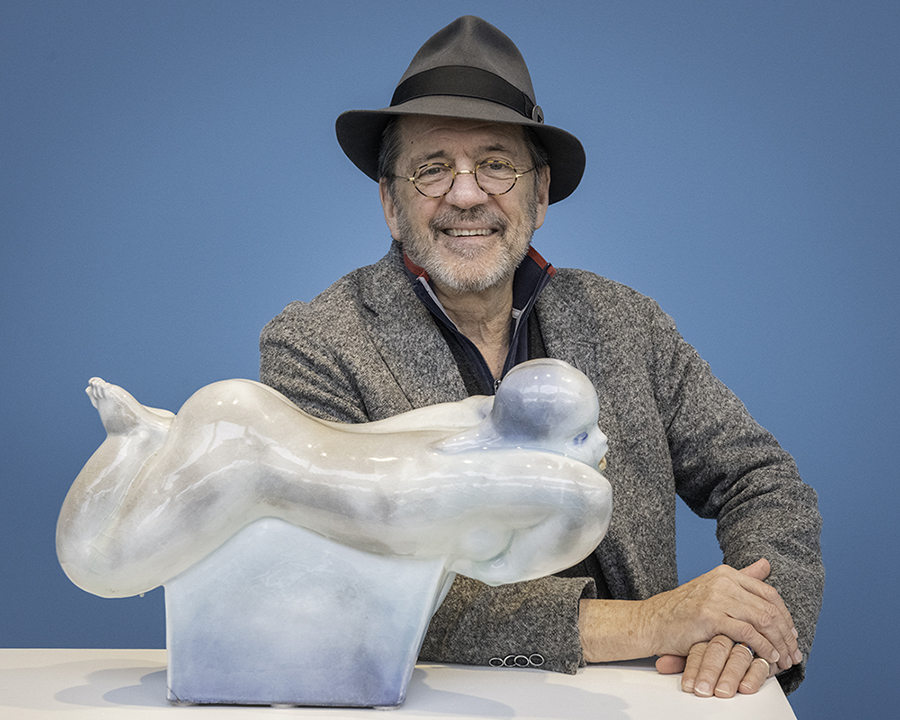 Wayne Higby with maquette for The Swimmer by Waylande Gregory (1933)
|
||
|
THE STATE OF AMERICAN CERAMIC ART Today, here in USA, we are living in a Kafkaesque time. This term Kafkaesque, based on the early 20th century literary work of Frank Kafka (1883-1924), is often employed to describe situations that are disorienting and illogically complex in a surreal or nightmarish way. American culture is disoriented and a drift. This is due to the Covid-19 epidemic, a political climate of distrust, media platforms flooded with disinformation as well as a newly intensified manifestation of identity politics that emerged out of the 1960s Black Civil Rights Movement, second wave feminism and gay and lesbian liberation. The USA is navigating a highly confrontational time. America art and artists as well as American educational and cultural intuitions have been asking questions, for some time, about the kind of art that should be made and for whom. However, today there is new urgency. An urgency that is affecting all the arts including ceramic art. |
As a professor of ceramic art and a curator-director of a ceramic art museum, I am currently working with black artists, Mexican and Latino artists, gay, lesbian and transgender artists in a very new, open and intense way. All artists as well as the all the major art institutions across America are in a period of reflection and reassessment. This past September, 2020, the Everson Museum of Art in Syracuse, New York, became the latest institution to sell off a major artwork to fund the diversify of its collection. The museum’s Jackson Pollock painting, Red Composition (1946), sold for $12 million. The proceeds will be used to fund acquisitions of work by artists of color, women artists, and others under-represented in the museum’s holdings. Identity and authenticity are more than ever before at the core of the artists’ struggle in American art and ceramic art. The celebrated theme of the individual revealing the universal is a classic story in American art, which is always at risk in the broader discordant picture of politics, economic struggle and the art market. Authenticity is fragile. |
||
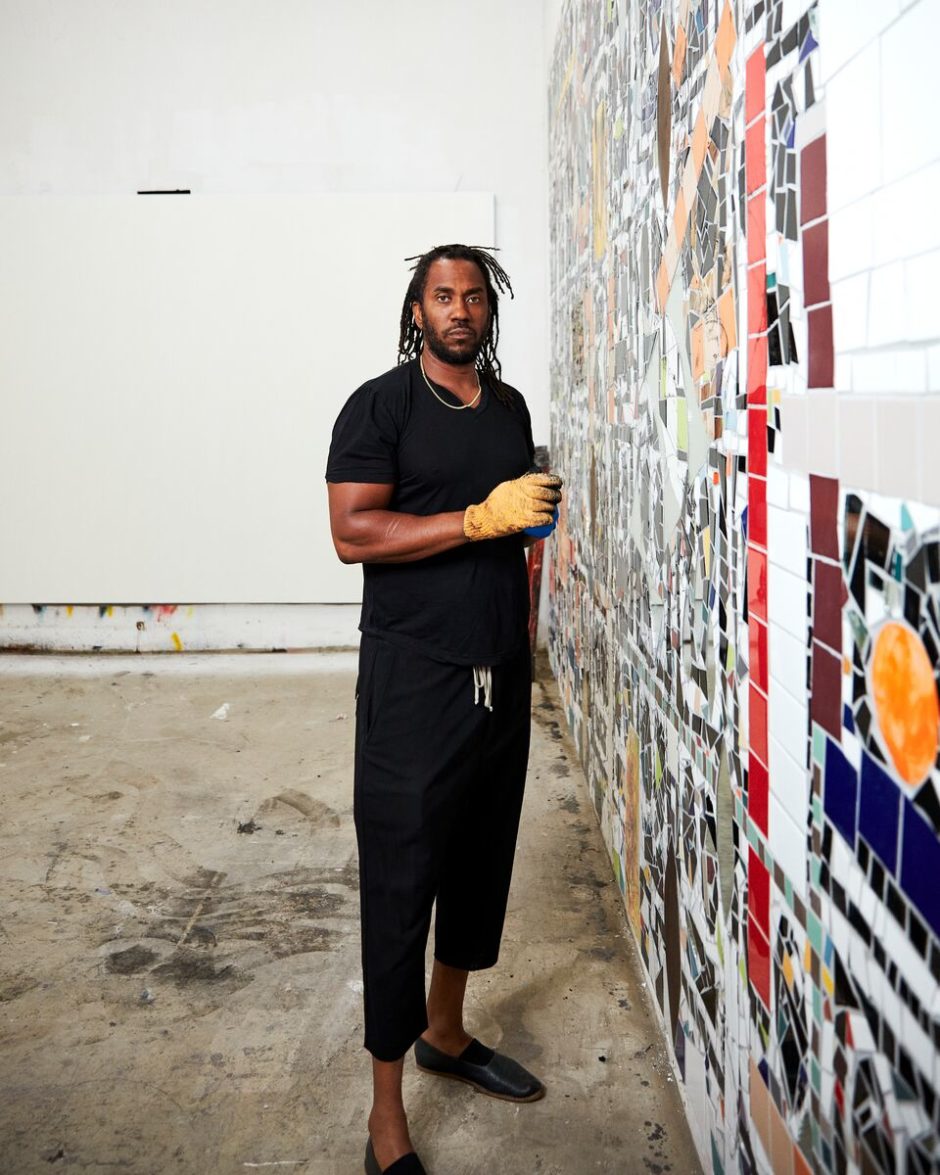 Artist Rashid Johnson at work on one of his ceramic mosaic walls |
The highly regarded Australian art critic Robert Hughes (1938-2012) writing in the New York Review, December 6, 1984 (36 years ago) offered the following visionary statement, which is quite credible today regarding American art and ceramic art: “We have a severe unemployment problem at the bottom and an exaggerated star-system at the top of the artist population; while among the consumers, we have a lot of free-floating anxiety that precipitates itself in fairly irrational ways, and is more vulnerable to fashion than ever before. The art world now looks more like the fashion industry.” There are, of course, always the few artists who seem to genuinely connect with their time by offering an impactful point of view that rises above mere fashion or trend. For example: currently, I am working with an arts organization on a commission for a huge ceramic, mosaic wall by Rashid Johnson. As an artist, he has captured an important aspect of the history of this moment in the U.S. and given it meaning. |
||
|
Art, ceramic art and ceramic artists will go on and on, of course. Art is at the heart of the human experience and is much bigger and more profound than the economic and social-political trends that surround it. Art – ceramic art will vanish when all problems and experiences, thoughts and feelings of countless new generations will have been resolved. There is no question, however, that today the environment in which art is made is changing. Covid-19 has pointed a necessary way – a path ceramic artists have been walking down for some time now in other parts of the world outside of the USA – smaller spaces, kitchen tables, limited resources. Nevertheless, or perhaps exactly because of the challenge limitations provide, creativity is on the move. Don’t look away, stay tuned – Remarkable work is on the horizon. Viruses, wars and poverty have fortunately not killed art. But right now artists of all persuasions in America are pushed close to the edge. Some great work will emerge from the chaos. Some good news, in celebration of the timelessness of ceramic art here in American and around the globe. A new book Ceramic Art and Civilization is on the horizon written by Paul Greenhalh of the UK. Recently, I had the pleasure of reviewing this book for Bloomsbury press for a publication date of January 2021. Most interestingly Greenhalgh makes an important point about books on ceramic art. “The thousands of books don’t add up to what we might call a historiography, a structured vision of the practice, or an interconnected set of narratives and ideas.” Greenhalgh has done a very credible job of solving that problem. |
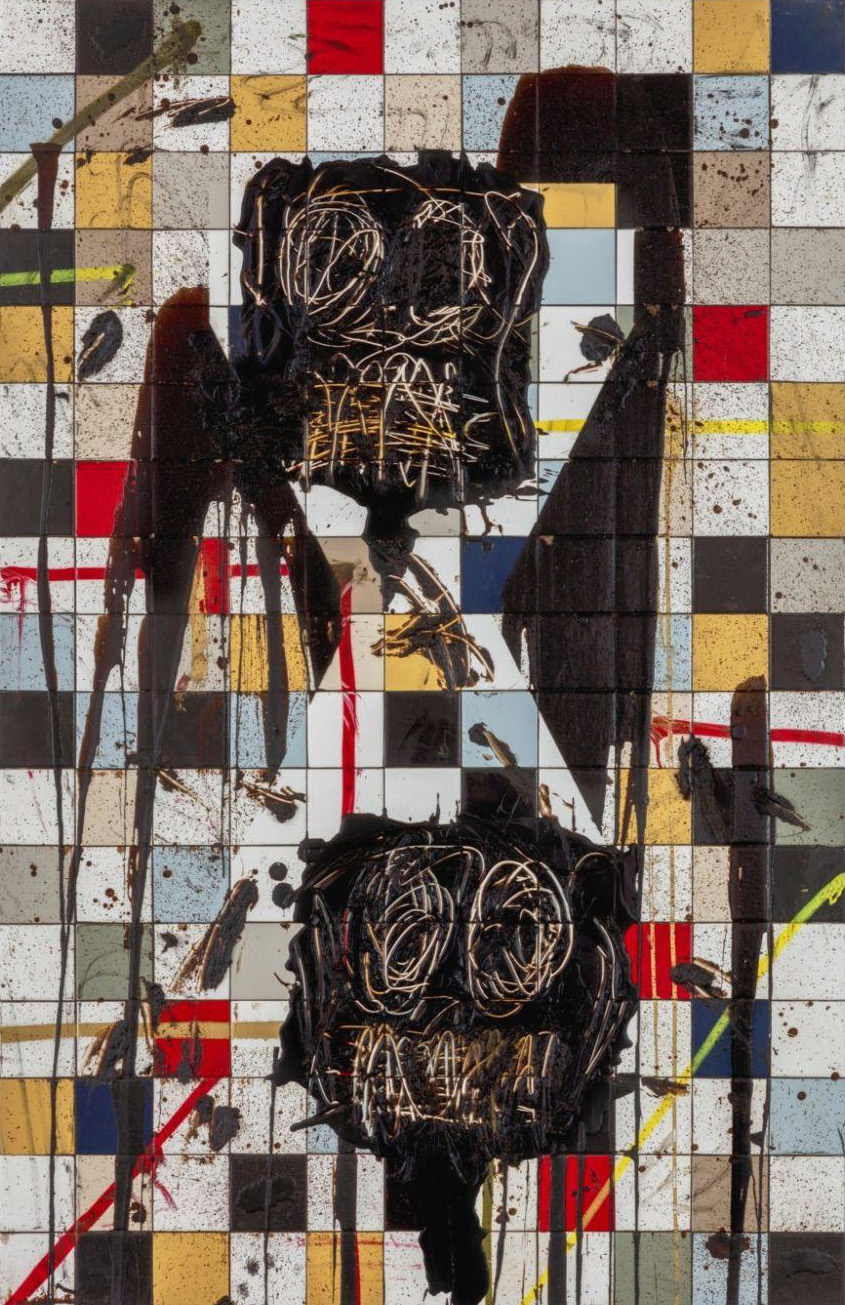 “Color Men” by Rashid Johnson Also, concerning new scholarship in ceramic art: The Alfred Ceramic Art Museum will mount in September 2021 an exhibition entitled The Path of the Tea Bowl: A Transnational Icon. This is to be a scholarly exhibition focusing exclusively on the Tea Bowl itself. Such an exhibition has not been done before and we are hoping to stimulate important dialogue about this seminal object of ceramic art. Long Live Ceramic Art! |
||
|
|
|
||
| POSTSCRIPT | |||
|
During this highly stressful, pandemic time it was especially good to see so many friends from across the world and at the Beijing Guozhong Ceramic Art Museum. At the conclusion of the program our goodbyes to each other were heart felt. I was reluctant to click leave meeting. We are passionate about ceramic art and that draws us together. Our current sense of isolation is drawing us together as well and that togetherness that we seek has a deep resonance that is fundamentally, poetically human. Looking deeply, a question arises: Is there something about this material clay and the ceramic process that uniquely generates friendship? I left the seminar with other questions as well. What is the role-responsibility of the material specific, ceramic art museum? Are such institutions a long range necessity? When I became the Director and Chief Curator of the Alfred Ceramic Art Museum, I confirmed our collection policy of attendending to ceramic art and changed the exhibition policy to include work in all media. This is a de-isolation gesture meant to help remove an engrained hierarchy in art media while maintaining the museum’s uniqueness. One result is the museum’s virtual reality exhibition Full Capacity that I mentioned during our seminar. |
Concurrent with the question about media specific museums is a question concerning the rise of the curator in the grand picture of art and art museums. During the past decade the curator has become the leading edge of a list of what I refer to as “Gatekeepers.” What is the gatekeeper’s responsibility? Who or what are the gatekeepers of ceramic art? How does this system function? How has it changed over time? Is this system simply a reflection of the practices and principles of the art world in general? I have many other questions, but one in particular is longstanding. How does media and process affect all other aspects of content in works of art? I am looking forward to our next opportunity to be together. Wayne Higby |
||
|
|||
Exposition des nouveaux membres de l’AIC 2020 et séminaire
L'exposition 2020 des nouveaux membres de l'AIC s'est tenue en novembre et décembre 2020 au Musée d'art céramique de Beijing Guozhong en Chine.
(read more...)Torbjørn Kvasbø – SEMINAR
Keynote speech by Torbjørn Kvasbø, IAC President 2018-2024 and IAC artist member since 1990.
(read more...)Wan Liya – SEMINAR
Wan Liya is a well-established Chinese ceramicist who is the IAC's Council representative for China for 2020-2026. His work is concerned with the legacy of Chinese ceramic traditions amidst rapid changes in contemporary society.
(read more...)Janet DeBoos – SEMINAR
Janet DeBoos is an accomplished Australian ceramicist and formerly the IAC's Council representative for Australia, New Zealand and Africa. She is known for her longstanding work with indigenous communities in Australia.
(read more...)Claudia Casali – Seminar
Claudia Casali is the Director of the International Museum of Ceramics in Faenza (MIC), Italy. Alongside her work she lectures, curates and collaborates with museums internationally as a jury member for ceramic competitions.
(read more...)

